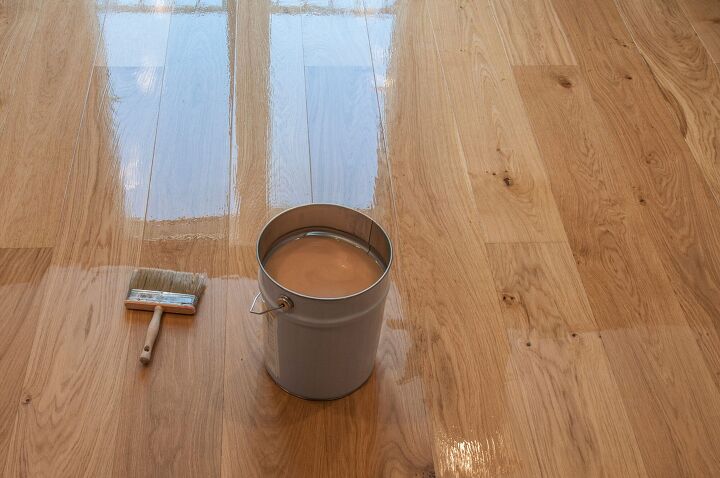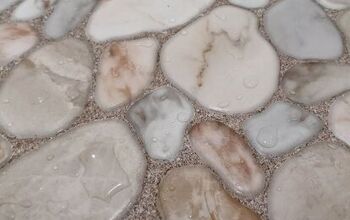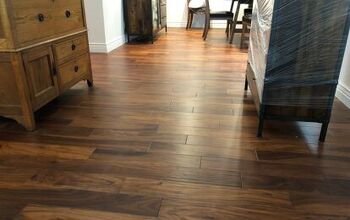What Are The Pros And Cons Of Oil-Finished Wood Floors?

When it comes to pre-finishing wood flooring, there are essentially two different methods that stem from taking two different approaches to wood – oil finishing vs. urethane finishing. While oil finish penetrates the wood to fortify and seal each individual fiber, urethane protects the wood by forming a plastic-like barrier over the wood.
Generally speaking, with oil-finished floors, you are walking on the surface of the treated wood. Whereas, with urethane finished floors, a protective layer exists between the wood and your feet. Determining what the best finish would be for your needs involves considering how the floor is going to be used, cleaned, and maintained. To do so, you must understand the pros and cons of each finishing method.
In other words, in order to make a proper comparison and understand the pros and cons of oil-finished wood floors, you must also understand the pros and cons of urethan finished floors. Let’s dive in.
Do You Need to Hire a Flooring Contractor?
Get free, zero-commitment quotes from pro contractors near you.

What is the Best Finish for Your Hardwood Floor? – Urethane vs. Oil
Of course, there are pros and cons involved with each method. However, the decision between oil-finished floors and urethane finished floors should be made based on how your wood flooring is used, cleaned, and maintained.
Urethane Finishing
How urethane finishing works is that it creates a protective layer on top of the flooring to protect the wood. This layer serves as a barrier between your feet and the wood floor. Urethane finish is incredibly durable and can be easily maintained with the simple use of appropriate wood floor cleaners. The main drawback to this type of finish is that when scratches occur, the only way to properly repair them is to remove all the furniture and apply a new coat of urethane finish.
Pros of Urethane Finished Floors
Known for its durability, urethane has been the most common finish used for many years. In fact, many of the top hardwood flooring manufacturers in the world use urethane with aluminum oxide, which provides an extra level of protection. The average urethane finish floor has between 9 and 11 coats of finish on each plank for optimum strength.
With such a highly durable coating, urethane finished wood floors are very easy to clean. All you’ll have to do is maintain a simple routine of sweeping and mopping with the use of a permitted wood floor cleaner.
Cons of Urethane Finished Floors
Believe it or not, the durability of urethane finished floors is also one of its drawbacks. If a scratch is deep enough to penetrate the finish – which will likely occur eventually – it can be challenging to recoat. If your home sees more foot traffic, including pets, children, and regular entertaining, you are more prone to scratches or gouges.
In order to repair damage to urethane finished floors, either all the boards will have to be completely replaced or you’ll need to resurface all adjacent areas. The reason for such extensive repair has to do with the fact that it is very difficult to blend the finish on a repaired section with the un-finished sections around it.
Urethane finished floors appear their best on the day of the installation. Over time, and with excessive use, your floors will become worn, scuffed, and scratched. Since you are walking on top of the protective coating rather than the wood floor itself, the damage usually shows up as white scratches on the finish.
To repair these damages, you’ll have to remove all the furniture in the room and apply a new, even fresh coat of urethane finish. In most cases, this recoating will have to be done every 10 to 12 years or so.
Oil Finishing
Instead of creating a protective layer on top of wood, oil finishing penetrates the wood to fortify and seal the individual fibers. Oil finishes have been popular across Europe for many years and are starting to gain popularity in the United States because of their low sheen, natural aesthetics, and composition. It has a much more rustic look when compared to the conventional urethane finish. Although oil finishing is not as durable as urethane, these finishes do offer more flexibility when it comes to fixing damage.
Pros of Oil-Finished Floors
The major advantage to oil-finished wood floors is the fact that the finish enhances the natural beauty of wood. They are also VOC free, plant-based, and eligible for LEED credits, which introduces fewer man-made chemicals into your home. Although oil finishes may not be as durable as their urethan counterparts, they make repairing damage much easier. When scratches occur, oiled floors can be easily buffed out.
Even with larger gouges and abrasions, you can easily sand down the affected area of the oiled floor and then re-stain and re-oil. Once the oil dries, it will blend effortlessly into the adjacent areas. With oil-finished floors, you don’t have to repair the entire floor, only the damaged section. As such, you’ll often see commercial projects, such as hotels and restaurants, opting for oil finishes on their wood floors.
Cons of Oil-Finished Floors
The main disadvantage to oil-finished wood floors is the very important and specific maintenance that they require. When compared to urethane floors, oiled floors require more regular cleanings using specialized soaps the occasional refreshment with oil to prevent the floor from drying out and splintering.
Although buying a specific cleaning product isn’t all that difficult, the largest inconvenience with these floors is the quarterly cleaning. Without regular cleanings, your wood floors will start to lose their luster. These cleanings usually involve the following crucial steps:
- Apply an oil refresher, diluted in a bucket of water.
- Use a mop to apply the solution to your floor.
- Let the floors air-dry on their own.
In about 7 to 10 years, or approximately the time that a urethane floor needs to be completely sanded and refinished, the following two-step process must be done to oil-finished wood floors.
- Apply a wood cleaner to the floor to open up the pores and remove contaminants.
- Buff in a master oil to refresh the flooring.
This process does not require a professional. You can even add a slight ting of color to the oil to enhance the color of your natural wood floors. While some may view this specific cleaning regimen as a hassle, it is more advantageous than the long-term costs and labor associated with refinishing urethane finished flooring.
Why Oil-Finished Floors?
With the pros and cons of both urethane finishing and oil finishing in mind, why might someone choose to opt for the latter?
The natural glow
Again, instead of resting on the surface of wood and forming a protective barrier, oil finishes soak deep into the wood to bond with it on a molecular level. As such, the texture and color of the wood is left unobstructed. In fact, over time, oil finishes produce a patina that ages alongside the wood – meaning you’ll never have that dull, worn look that typically comes with surface finishes.
Surprising durability
It’s not uncommon to hear concern about the durability of oil-finished floors, especially among those accustomed to urethane finishes. Fortunately, modern oil finishes are more resistant to damage and wear than the original oil finishes. When scratches do occur, they typically do not impact the beauty of the flooring and tend to blend in with the texture of the wood. With serious damage, the finish can be spot repaired very easily.
Safe for your family and the environment
When compared to other finishes, most natural oil finishes release fewer volatile organic compounds, or VOCs. As an added bonus, you can often get away with never having to refinish your wood floors again. Talk about sustainability. If you’re someone who is sensitive to VOCs in the air, oil-finished floors are simply the only way to go.
Do You Need to Hire a Flooring Contractor?
Get free, zero-commitment quotes from pro contractors near you.

Related Questions
Are oil-finished floors more expensive than urethane finished floors?
Generally speaking, using an oil finish on your wood floors will not cost you any more or less than if you were to use a urethane finish. Although you may need to “refinish” more often, refinishing oil-finished floors is substantially less expensive and labor intensive.
Do natural oil finishes come in different tints?
Unlike urethane finishes, oil finishes do come with a variety of different hues. This often eliminates the need for a stain. However, the finish will usually be a matte to satin. If you want a glossy look, it’s usually best to opt for urethane.
How often should I oil my wood floors?
If your oils were finished in oil or hard wax oil, a maintenance coat should be applied about every 16 to 24 months for residential applications and between six and eight months for commercial.
How do I know if my floors are oiled?
The best way to test the finish of your floor is to run your hand along the surface. If you feel the texture of the wood, the floor likely has a coating of natural oil finish. Though, this could also indicate a coating of wax. Test for wax by using the edge of a coin on an unsuspecting area, looking out for wax buildup on the coin.

Jessica considers herself a home improvement and design enthusiast. She grew up surrounded by constant home improvement projects and owes most of what she knows to helping her dad renovate her childhood home. Being a Los Angeles resident, Jessica spends a lot of her time looking for her next DIY project and sharing her love for home design.
More by Jessica Stone

















![Standard Dining Room Table Dimensions [for 4, 6, 8, 10 and 12 People]](https://cdn-fastly.upgradedhome.com/media/2023/07/31/9074335/standard-dining-room-table-dimensions-for-4-6-8-10-and-12-people.jpg?size=350x220)









